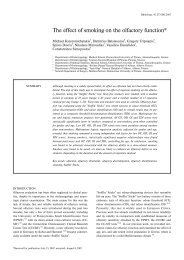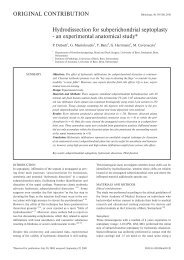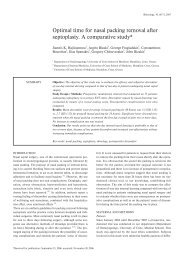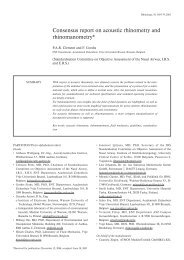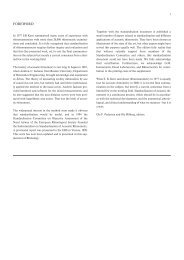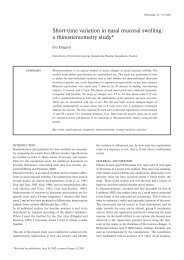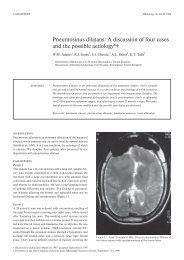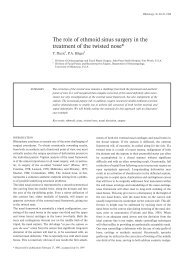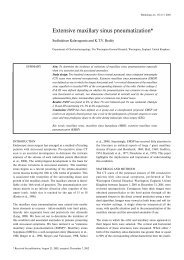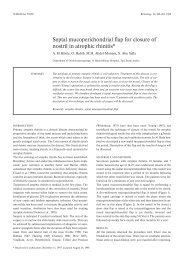IL-4 And TNF - Rhinology Internation Journal
IL-4 And TNF - Rhinology Internation Journal
IL-4 And TNF - Rhinology Internation Journal
Create successful ePaper yourself
Turn your PDF publications into a flip-book with our unique Google optimized e-Paper software.
240 Yoshifuku et al.<br />
and CRS is different in each study, differences in the background<br />
of the subjects and in the experimental methods might<br />
have affected the findings. In the present study, <strong>IL</strong>-4 significantly<br />
increased the secretion of eotaxin from nasal fibroblasts<br />
and co-stimulation with <strong>TNF</strong>-α and <strong>IL</strong>-4 remarkably enhanced<br />
the response. The effects of <strong>IL</strong>-4 and the synergy of <strong>TNF</strong>-α<br />
and <strong>IL</strong>-4 on eotaxin release were greater in Enp than in NEnp.<br />
This indicates that the fibroblasts present in Enp are more sensitive<br />
than those in NEnp to stimulation with <strong>IL</strong>-4 and combined<br />
stimulation with <strong>TNF</strong>-α and <strong>IL</strong>-4.<br />
Nonaka et al. (12) demonstrated the synergistic effects of <strong>IL</strong>-4<br />
and lipopolysaccharide on the production of eotaxin from normal<br />
nasal fibroblasts and from nasal polyp fibroblasts in a similar<br />
manner. Terada et al. (13) investigated the eotaxin production<br />
in human nasal fibroblasts isolated from inferior turbinate<br />
nasal mucosa of patients with perennial nasal allergy by RT-<br />
PCR and Southern blot analysis. They clearly demonstrated<br />
that both <strong>IL</strong>-13 and <strong>IL</strong>-4 induced eotaxin expression and that<br />
the combined stimulation of <strong>IL</strong>-4 and <strong>TNF</strong>-α, as well as that of<br />
<strong>IL</strong>-13 and <strong>TNF</strong>-α, synergistically enhanced the production of<br />
eotaxin. The mechanisms whereby <strong>TNF</strong>-α and <strong>IL</strong>-4 synergize<br />
to induce the production of eotaxin are not clear (13) . Lugli et<br />
al. (27) demonstrated that stimulation with <strong>TNF</strong>-α induced a<br />
two- to three-fold increase of <strong>IL</strong>-4R expression. However, our<br />
experiments showed that <strong>IL</strong>-4R expression was not increased<br />
by stimulation with <strong>TNF</strong>-α or by combined stimulation with<br />
<strong>TNF</strong>-α and <strong>IL</strong>-4. Moreover, expression of <strong>IL</strong>-4R did not differ<br />
significantly between Enp and NEnp. Furthermore, pre-incubation<br />
of nasal fibroblasts with <strong>TNF</strong>-α did not enhance eotaxin<br />
release induced by <strong>IL</strong>-4, and vice versa. Simultaneous stimulation<br />
with <strong>TNF</strong>-α and <strong>IL</strong>-4 was most effective in inducing<br />
the production of eotaxin (data not shown). These findings<br />
suggest that the increased production of eotaxin by combined<br />
stimulation with <strong>TNF</strong>-α and <strong>IL</strong>-4 in nasal fibroblasts of Enp as<br />
well as NEnp might be regulated by post-receptor events (13) . In<br />
fact, <strong>TNF</strong>-α stimulation leads to increased activation of the <strong>IL</strong>-<br />
4-specific signal transducers and activators of transcription protein<br />
(Stat6) by <strong>IL</strong>-4 (24) . It is also interesting that a significant<br />
difference between Enp and NEnp was observed only in the<br />
secretion of eotaxin induced by <strong>IL</strong>-4 or by simultaneous stimulation<br />
with <strong>TNF</strong>-α and <strong>IL</strong>-4. Hence, fibroblasts in Enp might<br />
be selectively primed for the production of eotaxin in response<br />
to stimulation with <strong>IL</strong>-4 and <strong>TNF</strong>-α.<br />
In addition to the synergistic effects with <strong>TNF</strong>-α and <strong>IL</strong>-4,<br />
immunological balance between T helper 1 (Th1) and Th2<br />
cytokines might be associated with the secretion of RANTES<br />
and eotaxin, since <strong>TNF</strong>-α is a Th1 and <strong>IL</strong>-4 is a Th2 cytokine.<br />
Fujisawa et al. (24) found that <strong>TNF</strong>-·-induced RANTES production<br />
from BEAS-2B cells was markedly enhanced by Th1<br />
cytokine IFN-γ and was not affected by Th2 cytokine <strong>IL</strong>-4.<br />
Moreover, IFN-γ inhibited eotaxin production induced by costimulation<br />
with <strong>TNF</strong>-α and <strong>IL</strong>-4. On the other hand,<br />
Lezcano-Meza et al. (28) found that <strong>IL</strong>-4 was the major stimulus<br />
for eotaxin-2 production from nasal polyps followed by <strong>IL</strong>-13<br />
and IFN-γ. Those findings suggested that Th1 as well as Th2<br />
cytokines regulate the production of RANTES and eotaxin and<br />
the degree of eosinophil infiltration in nasal polyps.<br />
In conclusion, the present study showed that eotaxin secretion<br />
from nasal fibroblasts was induced by stimulation with <strong>IL</strong>-4<br />
and synergistically enhanced by simultaneous stimulation with<br />
<strong>TNF</strong>-α and <strong>IL</strong>-4. The secreted level of eotaxin from fibroblasts<br />
was significantly higher in Enp than in NEnp. In contrast, the<br />
levels of VCAM-1 and RANTES did not differ significantly<br />
between Enp and NEnp. These findings suggest that eotaxin<br />
plays an important role in selective recruitment of eosinophils<br />
in Enp. Furthermore, nasal fibroblasts in Enp appear more<br />
sensitive than those in NEnp regarding eotaxin secretion<br />
induced by co-stimulation with <strong>TNF</strong>-α and <strong>IL</strong>-4. This might<br />
be associated with the pathogenesis of nasal polyposis having<br />
marked eosinophil infiltration.<br />
ACKNOWLEDGEMENT<br />
Financial support: Grant-in-Aids from the Ministry of<br />
Education, Science and Culture, and Ministry of Health and<br />
Welfare of Japan (B 17390463)<br />
REFERENCES<br />
1. Fokkens W, Lund V, Bachert C et al. Definition of rhinosinusitis<br />
and nasal polyps. European Position Paper on Rhinosinusitis and<br />
Nasal Polyps. <strong>Rhinology</strong> 2005; Suppl.18: 4-7.<br />
2. Ogata Y, Okinaka Y, Takahashi M. Detection of activated<br />
eosinophils in nasal polyps of an aspirin-induced asthma patient.<br />
<strong>Rhinology</strong> 1999; 37: 16-20.<br />
3. Dhong HJ, Kim HY, Cho DY. Histopathologic characteristics of<br />
chronic sinusitis with bronchial asthma. Acta Otolaryngol 2005;<br />
125: 169-176.<br />
4. Kim HY, Dhong HJ, Chung SK, Chung YJ, Kim MG. Clinical<br />
characteristics of chronic rhinosinusitis with asthma. Auris Nasus<br />
Larynx. 2006; 33: 403-408.<br />
5. Tuner U, Soylu L, Aydogan B, Karakus F, Akcali C. The effectiveness<br />
of steroid treatment in nasal polyposis. Auris Nasus Larynx<br />
2003; 30: 263-268.<br />
6. Higashi N, Taniguchi M, Mita H, Kawagishi Y, Ishii T, Higashi A,<br />
Osame M, Akiyama K. Clinical features of asthmatic patients with<br />
increased urinary leukotriene E4 excretion (hyperleukotrienuria):<br />
Involvement of chronic hyperplastic rhinosinusitis with nasal polyposis.<br />
J Allergy Clin Immunol 2004; 113: 277-283.<br />
7. Mantovani A. The chemokine system: redundancy for robust outputs.<br />
Immunol Today 1999; 20: 254-257.<br />
8. Cuvelier SL, Patel KD. Shear-dependent eosinophil transmigration<br />
on interleukin 4 stimulated endothelial cells: a role for<br />
endothelium-associated eotaxin-3. J Exp Med 2001; 194: 1699-<br />
1709.<br />
9. Chung KP, Tsai WS, Wang YJ, Shieh CC. Superoxide activates<br />
very late antigen-4 on an eosinophil cell adhesion molecule-1. Eur<br />
J Immunol 2003; 33: 645-655.<br />
10. Ohori J, Ushikai M, Sun D, Nishimoto K, Sagara Y, Fukuiwa T,<br />
Matsune S, Kurono Y. <strong>TNF</strong>-alpha upregulates VCAM-1 and NFkappaB<br />
in fibroblasts from nasal polyps. Auris Nasus Larynx. 2007;<br />
34: 177-183.<br />
11. Nonaka M, Pawankar R, Saji F, Yagi T. Eotaxin synthesis by nasal<br />
polyp fibroblasts. Acta Otolaryngol 1990; 119: 816-820.<br />
12. Nonaka M, Pawankar R, Fukumoto A, Ogihara N, Sakanushi A,<br />
Yagi T. Induction of eotaxin production by interleukin-4, inter-



